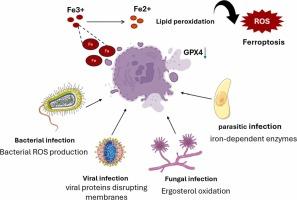揭示传染病中的铁下垂:从基础,机制途径,及其在感染中的双重作用到潜在的治疗意义
IF 7.5
2区 医学
Q1 MEDICINE, RESEARCH & EXPERIMENTAL
引用次数: 0
摘要
铁死亡是一种铁依赖性的受调节细胞死亡形式,其特征是脂质过氧化物的积累,将其与细胞凋亡、坏死和其他细胞死亡形式区分开来。最近的数据强调了它在传染性疾病中的关键作用,最初是对癌症和神经退行性疾病的研究。在细菌、病毒、真菌和寄生虫疾病中,本文综述了铁下垂如何导致微生物感染的深入研究。我们研究了不同的细菌如何通过使用或修改宿主的嗜铁过程来促进致病性、免疫逃避或生存。此外,我们研究了宿主的铁致凋亡反应作为一种潜在的防御机制,它在炎症和组织损伤中的双重作用,以及与免疫信号通路的相互作用。了解感染中铁下垂的机制基础可能会发现新的治疗靶点和传染病管理策略。通过整合跨领域的观点,本文是第一篇全面的综述,旨在突出铁下垂作为宿主-病原体相互作用的交汇点,具有重要的生物医学意义。本文章由计算机程序翻译,如有差异,请以英文原文为准。

Unraveling ferroptosis in infectious diseases: From basics, mechanistic pathways, and its dual role in the infections to potential therapeutic implications
Ferroptosis is an iron-dependent form of regulated cell death characterized by the accumulation of lipid peroxides, distinguishing it from apoptosis, necrosis, and other cell death modalities. Initially examined to cancer and neurodegeneration, the recent data underscore its pivotal role in infectious illnesses. Across bacterial, viral, fungal, and parasitic diseases, this review offers a thorough investigation of how ferroptosis contributes to microbial infections. We investigate how different bacteria either promote pathogenicity, immunological evasion, or survival by using or modifying host ferroptotic processes. Moreover, we examine the host’s ferroptotic response as a potential defense mechanism, its dual role in inflammation and tissue damage, and the interplay with immune signaling pathways. Understanding the mechanistic underpinnings of ferroptosis in infection may uncover novel therapeutic targets and strategies for infectious disease management. By integrating cross-kingdom perspectives, this paper is the first comprehensive review, which aims to highlight ferroptosis as a convergent point in host–pathogen interactions with significant biomedical implications.
求助全文
通过发布文献求助,成功后即可免费获取论文全文。
去求助
来源期刊
CiteScore
11.90
自引率
2.70%
发文量
1621
审稿时长
48 days
期刊介绍:
Biomedicine & Pharmacotherapy stands as a multidisciplinary journal, presenting a spectrum of original research reports, reviews, and communications in the realms of clinical and basic medicine, as well as pharmacology. The journal spans various fields, including Cancer, Nutriceutics, Neurodegenerative, Cardiac, and Infectious Diseases.

 求助内容:
求助内容: 应助结果提醒方式:
应助结果提醒方式:


